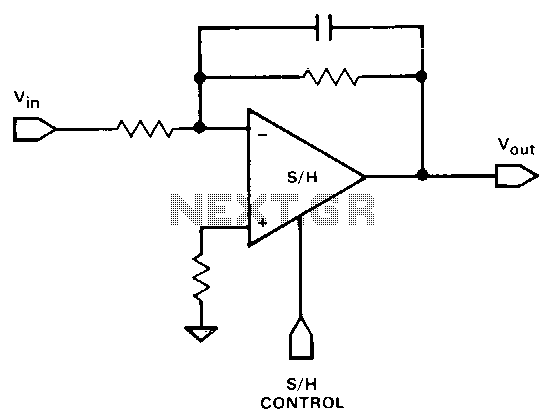
Filtered-sample-and-hold

It is often necessary to filter a signal prior to sampling. This can be achieved using a single device. Any of the inverting or non-inverting filters that can be constructed with operational amplifiers (op-amps) may be utilized. However, it is essential for the sampling switch to remain closed for a sufficient duration to allow the filter to settle when active filter types are connected to the device.
To create a reliable signal filtering and sampling circuit, an operational amplifier can be employed in either an inverting or non-inverting configuration. The choice between these configurations depends on the specific application requirements, such as gain, phase shift, and input/output impedance.
In an inverting filter configuration, the input signal is applied to the inverting terminal of the op-amp, while the non-inverting terminal is typically grounded. A feedback resistor is connected from the output to the inverting input, and an input resistor is connected from the input signal source to the inverting terminal. The transfer function of this filter can be designed to achieve various cutoff frequencies by selecting appropriate resistor and capacitor values.
Conversely, in a non-inverting filter configuration, the input signal is applied directly to the non-inverting terminal of the op-amp. The feedback and input resistors are arranged to set the gain of the circuit. This configuration is advantageous for applications requiring high input impedance, as it minimizes loading effects on the signal source.
Regardless of the filter type employed, it is crucial to ensure that the sampling switch is closed long enough to allow the output of the filter to stabilize. This settling time is particularly important when using active filters, as they can introduce phase shifts and transient responses that may affect the integrity of the sampled signal. The settling time can be influenced by factors such as the op-amp bandwidth, the order of the filter, and the characteristics of the components used in the circuit.
In summary, the implementation of a filtering circuit using op-amps prior to sampling is a critical step in signal processing. The specific configuration and design choices must be made carefully to ensure optimal performance and signal integrity.Itis often required that a signal be filtered prior to sampling. This can be accomplished with only one device. Use any of the inverting and noninverting filters that can be built with op amps. However, it is necessary that the sampling switch be closed for a sufficient time for the filter to settle when active filter types are connected around the device. 🔗 External reference
To create a reliable signal filtering and sampling circuit, an operational amplifier can be employed in either an inverting or non-inverting configuration. The choice between these configurations depends on the specific application requirements, such as gain, phase shift, and input/output impedance.
In an inverting filter configuration, the input signal is applied to the inverting terminal of the op-amp, while the non-inverting terminal is typically grounded. A feedback resistor is connected from the output to the inverting input, and an input resistor is connected from the input signal source to the inverting terminal. The transfer function of this filter can be designed to achieve various cutoff frequencies by selecting appropriate resistor and capacitor values.
Conversely, in a non-inverting filter configuration, the input signal is applied directly to the non-inverting terminal of the op-amp. The feedback and input resistors are arranged to set the gain of the circuit. This configuration is advantageous for applications requiring high input impedance, as it minimizes loading effects on the signal source.
Regardless of the filter type employed, it is crucial to ensure that the sampling switch is closed long enough to allow the output of the filter to stabilize. This settling time is particularly important when using active filters, as they can introduce phase shifts and transient responses that may affect the integrity of the sampled signal. The settling time can be influenced by factors such as the op-amp bandwidth, the order of the filter, and the characteristics of the components used in the circuit.
In summary, the implementation of a filtering circuit using op-amps prior to sampling is a critical step in signal processing. The specific configuration and design choices must be made carefully to ensure optimal performance and signal integrity.Itis often required that a signal be filtered prior to sampling. This can be accomplished with only one device. Use any of the inverting and noninverting filters that can be built with op amps. However, it is necessary that the sampling switch be closed for a sufficient time for the filter to settle when active filter types are connected around the device. 🔗 External reference